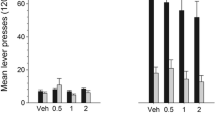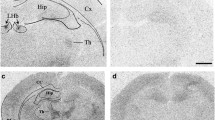Abstract
Rationale
Neurotensin (NT) has been implicated in some of the behavioral effects of psychostimulants. Thus, there is reason to think that NT may play a role in the reinstatement of cocaine seeking, and that it may do so via an interaction with dopamine (DA).
Objectives
To assess (1) whether NT and an NT analog, D-TYR[11]NT, induce reinstatement of cocaine seeking; (2) whether the effects of NT receptor activation on reinstatement can be modulated by D1/D5 or D2/D3 antagonists; (3) the specificity of the effects of NT receptor activation on the reinstatement of cocaine seeking.
Methods
In Experiment 1, rats were initially trained to self-administer cocaine. Following a subsequent period of extinction training, they were tested for the reinstatement of cocaine seeking by NT or D-TYR[11]NT (15, 30 μg i.c.v.). In Experiment 2, rats were pretreated with the D1/D5 antagonist, SCH 23390 (0.05, 0.10 mg/kg i.p.) or the D2/D3 antagonist, raclopride (0.25, 0.50 mg/kg i.p.), prior to testing for reinstatement by D-TYR[11]NT (15 μg i.c.v.). In Experiment 3, rats that had been trained to self-administer sucrose pellets were tested for the reinstatement of sucrose seeking by D-TYR[11]NT (15, 30 μg i.c.v.).
Results
(1) Both NT and D-TYR[11]NT produced robust reinstatement of cocaine seeking; (2) the effect of the analog was attenuated by pretreatment with the D1/D5, but not D2/D3, receptor antagonist; (3) the analog did not induce the reinstatement of sucrose seeking.
Conclusions
The findings suggest that an interaction between NT and DA may contribute to the neurobiology of reinstatement in animals with a history of cocaine self-administration.



Similar content being viewed by others
References
Beauregard M, Ferron A, Descarries L (1992) Opposite effects of neurotensin on dopamine inhibition in different regions of the rat brain: an iontophoretic study. Neuroscience 47:613–619
Blackburn A, Dewar K, Bauco P, Rompre PP (2004) Excitotoxic lesions of the prefrontal cortex attenuate the potentiation of amphetamine-induced locomotion by repeated neurotensin receptor activation. Brain Res 998:184–193
Blaha CD, Coury A, Fibiger HC, Phillips AG (1990) Effects of neurotensin on dopamine release and metabolism in the rat striatum and nucleus accumbens: cross-validation using in vivo voltammetry and microdialysis. Neuroscience 34:699–705
Cador M, Kelley AE, Le Moal M, Stinus L (1986) Ventral tegmental area infusion of substance P, neurotensin and enkephalin: differential effects on feeding behavior. Neuroscience 18:659–699
Capriles N, Rodaros D, Sorge RE, Stewart J (2003) A role for the prefrontal cortex in stress-and cocaine-induced reinstatement of cocaine seeking in rats. Psychopharmacol (Berl) 168:66–74
Checler F, Vincent JP, Kitabgi P (1983) Neurotensin analogs [D-TYR11] and [D-PHE11]neurotensin resist degradation by brain peptidases in vitro and in vivo. J Pharmacol Exp Ther 227:743–748
Day HEW, Vittoz NM, Oates MM, Badiani A, Watson Jr SJ, Robinson TE, Akil H (2002) A 6-hydroxydopamine lesion of the mesostriatal dopamine system decreases the expression of corticotropin releasing hormone and neurotensin mRNAs in the amygdala and bed nucleus of the stria terminalis. Brain Res 945:151–159
Erb S, Stewart J (1999) A role for the bed nucleus of the stria terminalis, but not the amygdala, in the effects of corticotropin-releasing factor on stress-induced reinstatement of cocaine seeking. J Neurosci 19(RC35):1–6
Erb S, Shaham Y, Stewart J (1998) The role of corticotropin-releasing factor and corticosterone in stress- and cocaine-induced relapse to cocaine seeking in rats. J Neurosci 18:5529–5536
Erb S, Shaham Y, Stewart J (2001) Stress-induced relapse to drug seeking in the rat: role of the bed nucleus of the stria terminalis and amygdala. Stress 4:289–303
Erb S, Funk D, Le A (2003) Prior, repeated exposure to cocaine potentiates locomotor responsivity to central injections of corticotropin-releasing factor (CRF) in rats. Psychopharmacol 170:383–389
Erb S, Lopak V, Smith C (2004) Cocaine pre-exposure produces a sensitized and context-specific c-fos mRNA response to footshock stress in the central nucleus of the amygdala. Neuroscience 129:719–725
Hawkins MF (1985) Central nervous system neurotensin and feeding. Physiol Behav 36:1–8
Jennes L, Stumpf WE, Kalivas PW (1982) Neurotensin: topographical distribution in rat brain by immunohistochemistry. J Comp Neurol 210:211–224
Kalivas PW, Duffy P (1990) Effect of acute and daily neurotensin and enkephalin treatments on extracellular dopamine in the nucleus accumbens. J Neurosci 10:2940–2949
Kalivas PW, McFarland K (2003) Brain circuitry and the reinstatement of cocaine-seeking behavior. Psychopharmacol 168:44–56
Kalivas PW, Jennes L, Nemeroff CB, Prange AJ Jr (1982) Neurotensin: topographical distribution of brain sites involved in hypothermia and antinociception. J Comp Neurol 210:225–238
Kinkead B, Nemeroff CB (2002) Neurotensin: an endogenous antipsychotic? Curr Opin Pharmacol 2:99–103
Luttinger D, King RA, Sheppard D, Strupp J, Nemeroff CB, Prange AJ Jr (1982) The effect of neurotensin on food consumption in the rat. Eur J Pharmacol 81:499–503
McFarland K, Kalivas PW (2001) The circuitry mediating cocaine-induced reinstatement of drug-seeking behavior. J Neurosci 21:8655–8663
McFarland K, Lapish CC, Kalivas PW (2003) Prefrontal glutamate release into the core of the nucleus accumbens mediates cocaine-induced reinstatement of drug seeking. J Neurosci 23:3531–3537
McFarland K, Davidge SB, Lapish CC, Kalivas PW (2004) Limbic and motor circuitry underlying footshock-induced reinstatement of cocaine seeking behavior. J Neurosci 24:1551–1560
Nemeroff CB, Luttinger D, Hernandez DE, Mailman RB, Mason GA, Davis SD, Widerlov E, Frye GD, Kilts CD, Beaumont K, Breese GR, Prange AJ Jr (1983) Interactions of neurotensin and brain dopamine systems: biochemical and behavioral studies. J Pharmacol Exp Ther 225:337–345
Panayi F, Colussi-Mas J, Lambas-Senas L, Renaud B, Scarna H, Berod A (2004) Endogenous neurotensin in the ventral tegmental area contributes to amphetamine behavioral sensitization. Neuropsychopharmacol [Epub ahead of print]
Paxinos G, Watson C (1997) The rat brain in stereotaxic coordinates, 3rd (edn.) Academic Press
Pilotte NS, Mitchell WM, Sharpe LG, De Souza E, Dax EM (1991) Chronic cocaine administration and withdrawal from cocaine modify central neurotensin receptors in rats. NIDA Res Monogr 105:541–542
Placenza FM, Fletcher PJ, Rotzinger S, Vaccarino FJ (2004) Infusion of the substance P analogue, DiMe-C7, into the ventral tegmental area induces reinstatement of cocaine-seeking behaviour in rats. Psychopharmacol (Berl) 177:111–120
Quirion R, Chiueh CC, Everist HD, Pert A (1985) Comparative localization of neurotensin receptors on nigrostriatal and mesolimbic dopaminergic terminals. Brain Res 327
Rompré PP (1995) Psychostimulant-like effect of central microinjection of neurotensin on brain stimulation reward. Peptides 16:1417–1420
Rompré PP (1997) Repeated activation of neurotensin receptors sensitizes to the stimulant effect of amphetamine. Eur J Pharmacol 328:131–134
Rompre PP, Perron S (2000) Evidence for a role of endogenous neurotensin in the initiation of amphetamine sensitization. Neuropharmacol 39:1880–1892
Sakai R, Ma L, He P, Fluharty S (1995) Intracerebroventricular administration of angiotensin type 1 (AT1) receptor antisense oligonucleotides attenuate thirst in the rat. Regul Pept 59:183–192
Shaham Y, Funk D, Erb S, Brown T, Walker C-D, Stewart J (1997) Corticotropin-releasing factor, but not corticosterone, is involved in stress-induced relapse to heroin-seeking in rats. J Neurosci 17:2605–2614
Shaham Y, Erb S, Stewart J (2000) Stress-induced relapse to heroin and cocaine seeking in rats: a review. Brain Res Rev 33:13–33
Studler J-M, Kitabgi P, Tramu G, Herve D, Glowinski J, Tassin J-P (1988) Extensive co-localization of neurotensin with dopamine in rat meso-cortico-frontal dopaminergic neurons. Neuropeptides 11:95–100
Acknowledgements
We thank Daniel Yi for expert technical assistance. This work was supported by a grant from the Natural Sciences and Engineering Research Council of Canada to S.E.
Author information
Authors and Affiliations
Corresponding author
Rights and permissions
About this article
Cite this article
Lopak, V., Erb, S. Activation of central neurotensin receptors reinstates cocaine seeking in the rat: modulation by a D1/D5, but not D2/D3, receptor antagonist. Psychopharmacology 182, 297–304 (2005). https://doi.org/10.1007/s00213-005-0089-1
Received:
Accepted:
Published:
Issue Date:
DOI: https://doi.org/10.1007/s00213-005-0089-1




